Orioles are among the most vibrant and charismatic songbirds in the Americas. Known for their striking orange, yellow, and black plumage, these birds captivate birdwatchers and wildlife enthusiasts alike. Understanding the types of orioles is essential not only for proper identification but also for appreciating their unique behaviors, habitats, and ecological roles. From the familiar Baltimore Oriole flitting through suburban backyards to the exotic Black-hooded Oriole in tropical forests, each species has its own charm. In this article, we’ll explore 20 captivating species of orioles, providing a detailed guide for beginners and seasoned birders alike. You’ll learn how to identify them, understand their habitats, and gain insights into their behaviors—all in one comprehensive resource.
1. Baltimore Oriole (Icterus galbula)
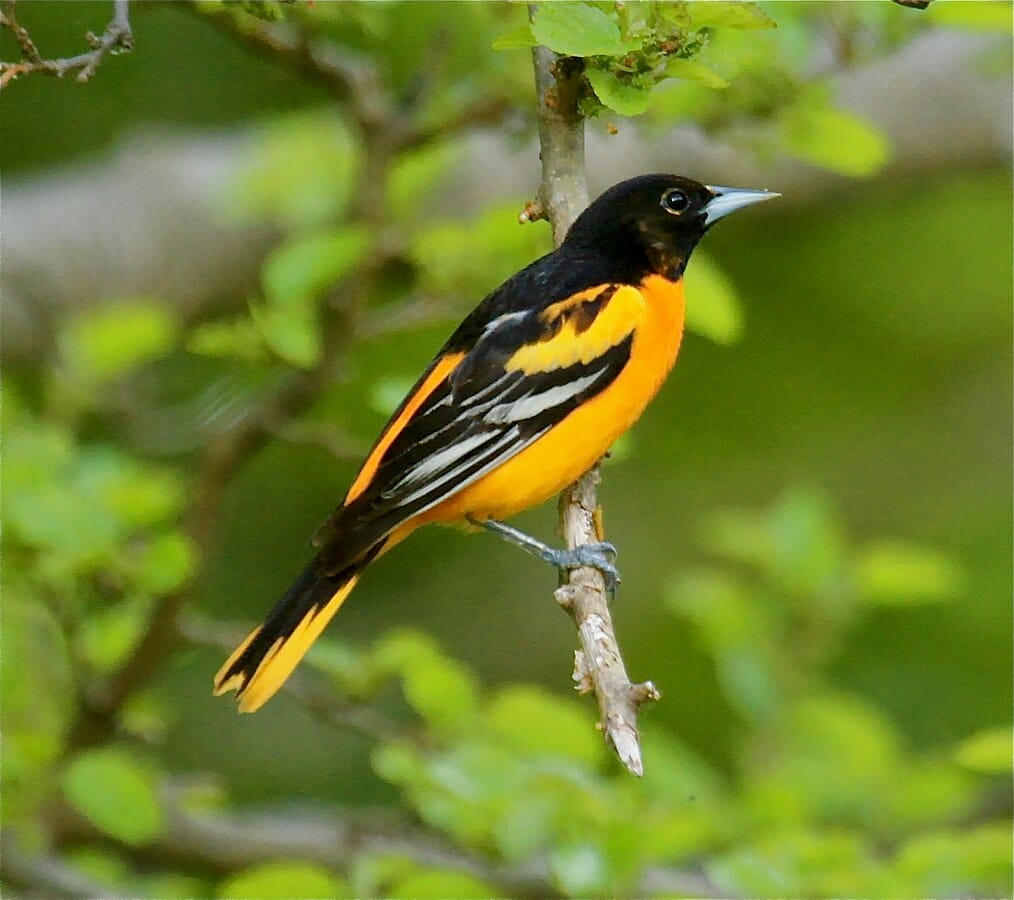
The Baltimore Oriole is arguably the most recognizable oriole in North America, famed for its fiery orange chest and black head. Male Baltimore Orioles boast vibrant colors that make them a favorite among birdwatchers, while females tend to be more subdued with yellowish-orange plumage and olive-brown wings.
Identification Tips:
Size: Approximately 7–8 inches long with a wingspan of 9–12 inches
Coloration: Bright orange breast, black head and back, white wing bars
Distinguishing Feature: Males have the striking black “mask” across their face
Habitat and Range:
Baltimore Orioles breed in the eastern and central United States and migrate to Central America during winter. They prefer open woodlands, forest edges, and suburban parks, often visiting backyards with fruit trees or nectar feeders.
Behavior and Diet:
These orioles are active, agile foragers. Their diet consists mainly of insects, fruits, and nectar. Baltimore Orioles are known for their unique hanging nests, woven intricately from plant fibers and suspended from tree branches.
Tips for Birdwatchers:
Listen for their rich, melodic whistles in late spring and early summer.
Plant fruiting trees and provide orange halves or nectar feeders to attract them.
Baltimore Orioles are a benchmark species for anyone interested in the types of orioles, embodying the beauty and behavioral charm that makes orioles so beloved.
2. Bullock’s Oriole (Icterus bullockii)
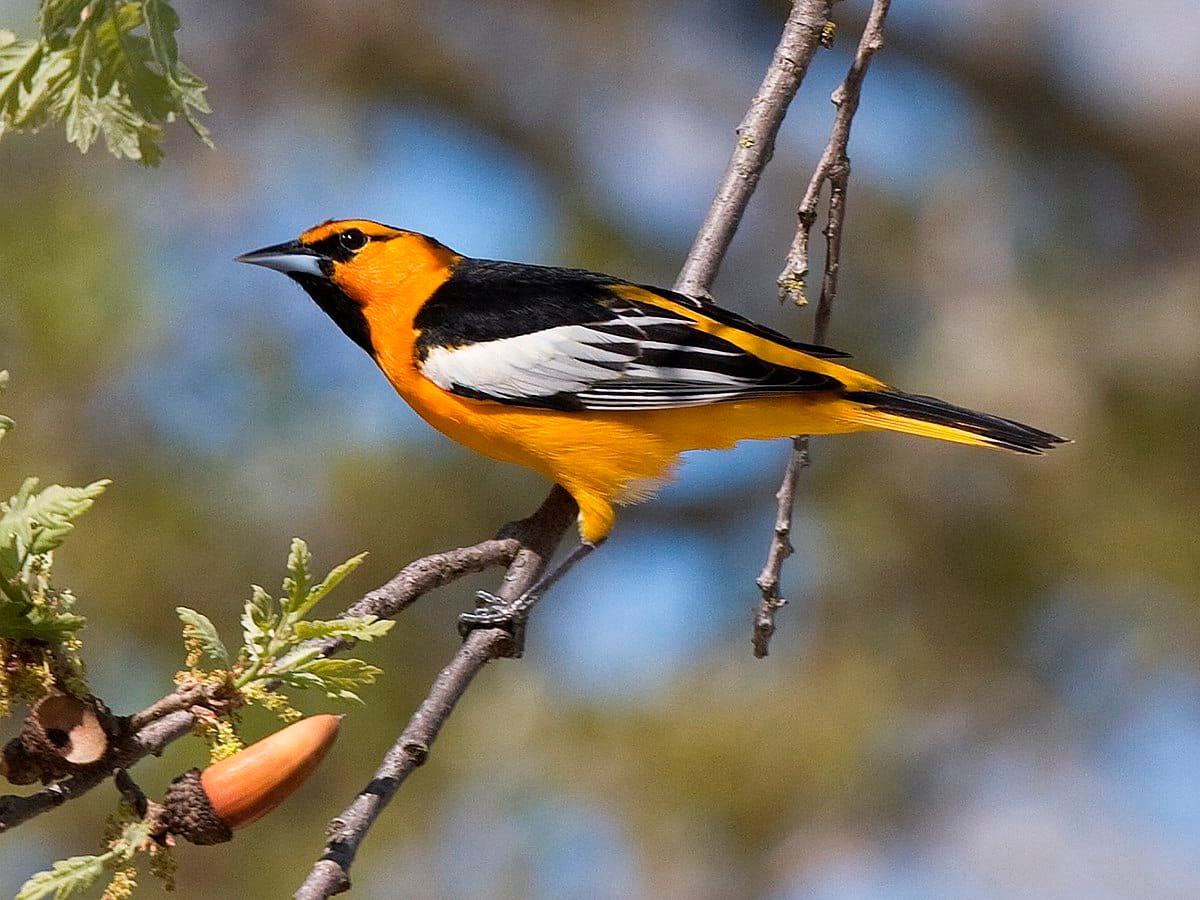
Bullock’s Oriole is primarily found in the western regions of North America and is distinguished by its striking orange and white plumage contrasted with black markings. Male Bullock’s Orioles are particularly vivid, featuring an orange throat and breast, white wing patches, and a black line running down the chest.
Identification Tips:
Size: 7–8 inches long, similar to the Baltimore Oriole
Coloration: Bright orange front, white wing bars, black head markings
Distinguishing Feature: The black eye stripe and contrasting white wing patches
Habitat and Range:
Bullock’s Orioles inhabit open woodlands, riparian zones, and desert scrub in the western U.S. and parts of Canada. During winter, they migrate southward to Mexico and Central America.
Behavior and Diet:
These orioles are skilled insect hunters and fruit eaters. They are known for their acrobatic feeding behavior, often hanging upside down to reach insects and nectar. Their woven, pouch-like nests are suspended from slender tree branches, making them difficult for predators to access.
Tips for Birdwatchers:
Visit riparian areas or parks in the western U.S. during summer to spot these birds.
Use colorful fruits and nectar feeders to attract them to your backyard.
Bullock’s Oriole exemplifies the diversity within types of orioles, showcasing different color patterns and habitat preferences while maintaining the species’ characteristic vibrancy and charm.
3. Orchard Oriole (Icterus spurius)
Smaller than its Baltimore and Bullock cousins, the Orchard Oriole is a delicate, slender bird often overlooked due to its size. Males are chestnut-colored with a black head and back, while females display a yellow-green plumage with a more subtle appearance.
Identification Tips:
Size: 6–7 inches long, wingspan 9 inches
Coloration: Males have rich chestnut underparts, black heads, and backs; females are greenish-yellow
Distinguishing Feature: The smaller size and rich chestnut tones of males
Habitat and Range:
Orchard Orioles are widespread across eastern North America during the breeding season. They favor orchards, open woodlands, and hedgerows. In winter, they migrate to Central America and northern South America.
Behavior and Diet:
These orioles are highly active, foraging in trees and shrubs for insects, spiders, and berries. They are known for their distinctive flask-shaped hanging nests, often attached to the tips of slender branches.
Tips for Birdwatchers:
Early morning visits to orchards or open woodlands increase sighting chances.
Listen for their soft, musical calls when observing them in dense foliage.
Orchard Orioles, with their smaller stature and graceful movements, add variety to the list of types of orioles, demonstrating how size and color can vary dramatically among species.
4. Hooded Oriole (Icterus cucullatus)
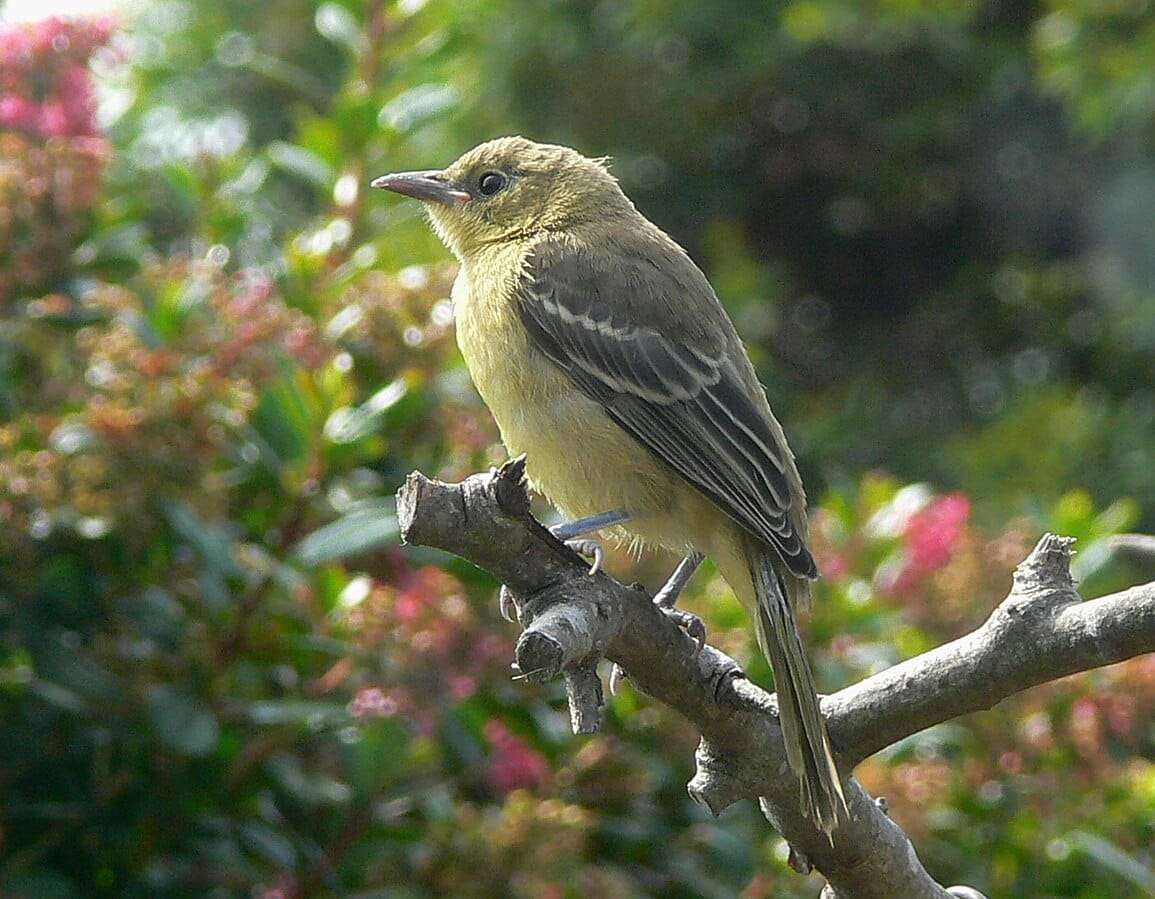
The Hooded Oriole stands out with its bright orange-yellow body and striking black hood extending over the head and throat. This species is most commonly found in the southwestern United States and Mexico.
Identification Tips:
Size: 7–8 inches in length
Coloration: Vibrant orange-yellow body, black hood, white wing bars
Distinguishing Feature: The hooded black head is unmistakable
Habitat and Range:
Hooded Orioles prefer palm trees, desert oases, and urban areas with ornamental trees. They are migratory birds, wintering in Mexico and Central America.
Behavior and Diet:
Primarily insectivorous and frugivorous, Hooded Orioles forage for insects, nectar, and small fruits. Their nests are intricately woven from plant fibers and suspended from palm fronds or slender branches.
Tips for Birdwatchers:
Plant nectar-rich flowers or provide sugar water feeders to attract them.
Look for their distinctive hanging nests in tall palm trees during the breeding season.
The Hooded Oriole demonstrates the vibrant variation found in types of orioles, particularly in southwestern habitats, combining beauty with remarkable nesting skills.
5. Scott’s Oriole (Icterus parisorum)
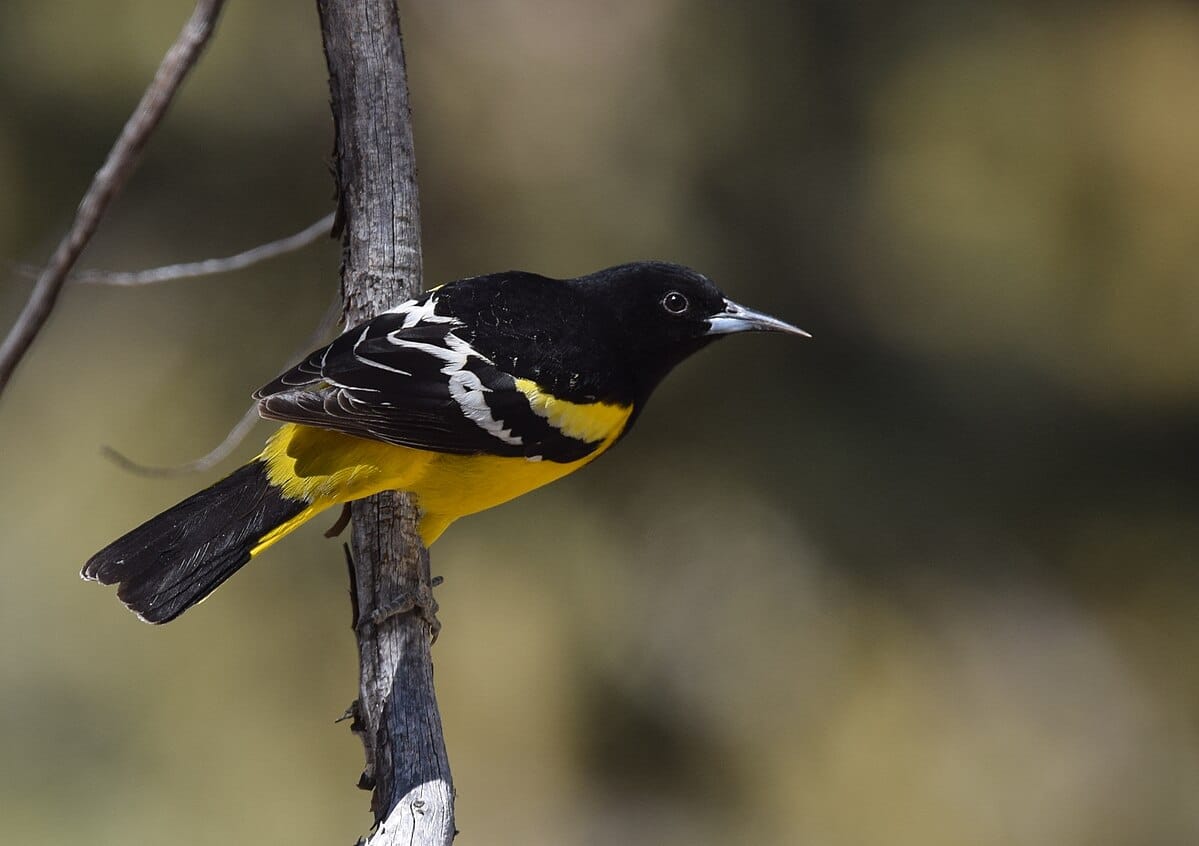
Scott’s Oriole is a striking species with bright yellow underparts and contrasting black upperparts. Unlike the Hooded Oriole, it displays a more uniform black back and wings, making it distinctive among southwestern North American orioles.
Identification Tips:
Size: 8–9 inches long, wingspan 10–12 inches
Coloration: Bright yellow belly and underparts, solid black back and wings
Distinguishing Feature: The uniform black and yellow contrast
Habitat and Range:
Scott’s Orioles inhabit desert scrub, canyons, and open woodlands in the southwestern U.S. and northern Mexico. They are largely resident birds but may make local movements depending on food availability.
Behavior and Diet:
Scott’s Orioles forage for insects, nectar, and berries. They construct unique hanging nests woven from plant fibers and grass, often attached to spiny desert plants for protection.
Tips for Birdwatchers:
Explore arid landscapes and desert parks in southwestern states to spot these birds.
Listen for their buzzy, musical calls that differ from other orioles in the region.
Scott’s Oriole is an excellent example of the types of orioles adapted to arid habitats, showcasing how environment influences both behavior and appearance.
6. Altamira Oriole (Icterus gularis)
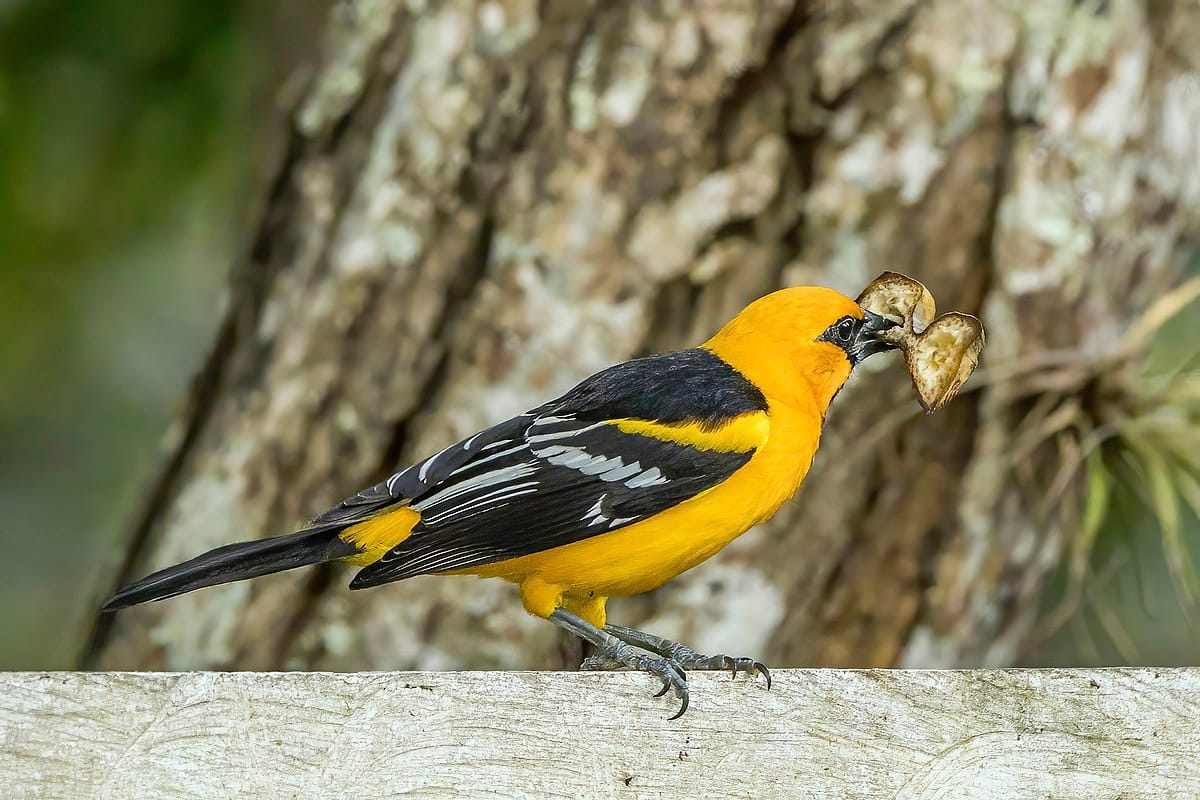
The Altamira Oriole is one of the largest North American orioles, renowned for its bright orange-yellow plumage and bold black markings. Its striking colors make it a favorite among birdwatchers in southern Texas and northeastern Mexico.
Identification Tips:
Size: 9–10 inches long, wingspan 12 inches
Coloration: Brilliant orange-yellow body with black throat, face, and wings
Distinguishing Feature: Large size and bold black-and-orange contrast
Habitat and Range:
Altamira Orioles inhabit semi-arid woodlands, thorn forests, and riparian zones in southern Texas, Mexico, and parts of Central America. They tend to prefer tall trees near water sources, providing both food and nesting sites.
Behavior and Diet:
These orioles feed on insects, nectar, and fruits. They are skilled foragers, often observed probing flowers and fruiting branches for sustenance. Their nests are large, pendulous structures woven from grass and plant fibers, suspended from high tree limbs to protect against predators.
Tips for Birdwatchers:
Late spring and early summer are ideal for observing these orioles in Texas and Mexico.
Providing nectar feeders or fruit slices can attract Altamira Orioles to gardens and parks.
The Altamira Oriole exemplifies the diversity among types of orioles, with its impressive size and vivid coloration making it a standout species for enthusiasts.
7. Audubon’s Oriole (Icterus graduacauda)

Audubon’s Oriole is a striking bird primarily found in southern Texas and northeastern Mexico. It is closely related to the Baltimore and Bullock’s Orioles but has its own distinct black-and-yellow coloration.
Identification Tips:
Size: 7–8 inches long
Coloration: Bright yellow underparts, black head, back, and wings, with white wing bars
Distinguishing Feature: The combination of solid black upperparts with vibrant yellow belly
Habitat and Range:
Audubon’s Orioles prefer riverine woodlands, mesquite groves, and forest edges. They are migratory, moving southward during winter to Central America.
Behavior and Diet:
This species primarily consumes insects, nectar, and small fruits. Audubon’s Orioles are active foragers, often seen flitting through trees and shrubs in search of food. Their nests are pendulous and carefully woven, usually suspended from the tips of thin branches for safety.
Tips for Birdwatchers:
Visit riparian woodlands and open forests during spring and summer for the best viewing opportunities.
Listen for their varied, musical songs that can help identify them even in dense foliage.
Audubon’s Oriole adds to the rich variety of types of orioles, showcasing both unique coloration and distinctive habitat preferences.
8. Streak-backed Oriole (Icterus pustulatus)
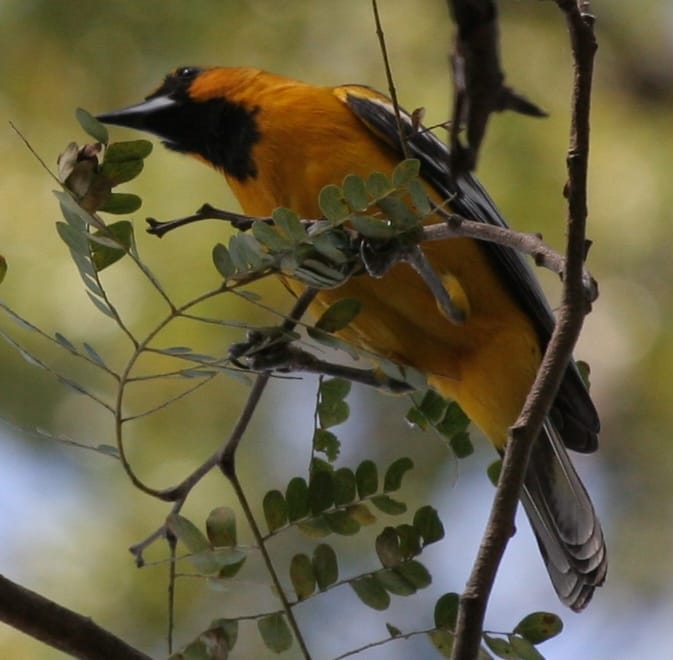
The Streak-backed Oriole is notable for its olive-green back streaked with black, contrasting with bright yellow underparts. It is a striking species found primarily in Mexico and parts of Central America.
Identification Tips:
Size: 8–9 inches long
Coloration: Bright yellow belly, streaked olive-green back, black wings
Distinguishing Feature: Unique streaked pattern on the back, uncommon among other oriole species
Habitat and Range:
Streak-backed Orioles inhabit forest edges, scrublands, and subtropical woodlands. They are largely resident birds, with minimal migratory movements, although local dispersal may occur based on food availability.
Behavior and Diet:
These orioles feed on a variety of insects, nectar, and fruit. They are active, acrobatic foragers, often hanging upside down to access food. Their nests are pendulous and intricately woven, typically suspended from branches to avoid predation.
Tips for Birdwatchers:
Look for them in subtropical and tropical woodlands during the day, especially near flowering trees.
Observing their streaked back is key for positive identification.
The Streak-backed Oriole illustrates the diversity in types of orioles, particularly in terms of coloration and habitat specialization.
9. Spot-breasted Oriole (Icterus pectoralis)
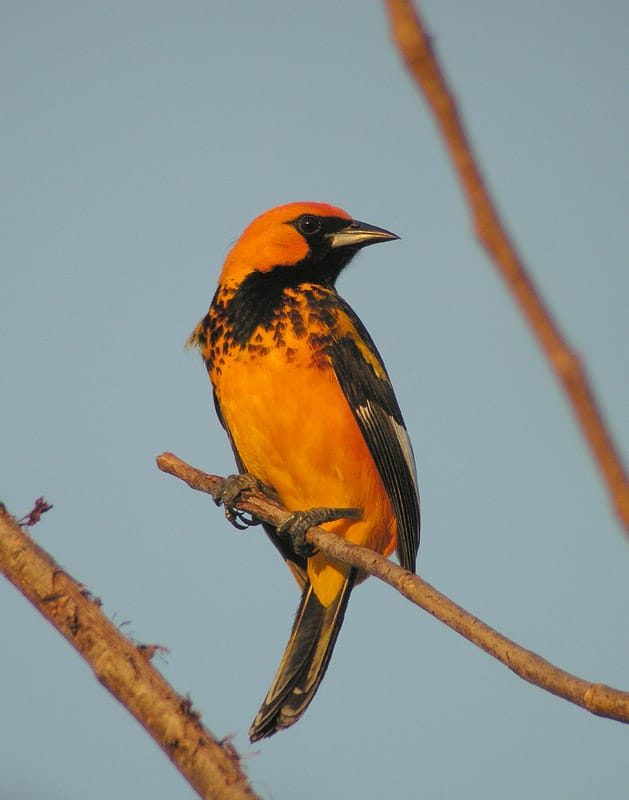
The Spot-breasted Oriole is easily recognized by its vibrant orange body and distinctive black spots on the chest, a unique feature among orioles. It is native to Central America and often found in open forests and plantations.
Identification Tips:
Size: 8–9 inches long
Coloration: Bright orange with black chest spots, black wings, and tail
Distinguishing Feature: Unique spotted breast pattern
Habitat and Range:
Spot-breasted Orioles prefer forest edges, gardens, and plantations in countries such as Honduras, Nicaragua, and Costa Rica. They are resident birds and adapt well to secondary forests and human-modified habitats.
Behavior and Diet:
Their diet consists of insects, nectar, and various fruits. They are agile feeders, often observed moving quickly between branches. Nesting involves weaving hanging nests from plant fibers and grasses, securely attached to tree limbs.
Tips for Birdwatchers:
Visit gardens and forest edges in Central America during the breeding season.
Their unique spotted breast makes them easy to identify among other oriole species.
The Spot-breasted Oriole showcases how variation in plumage and patterns contributes to the richness of types of orioles, making it a visually striking species.
10. Black-vented Oriole (Icterus wagleri)
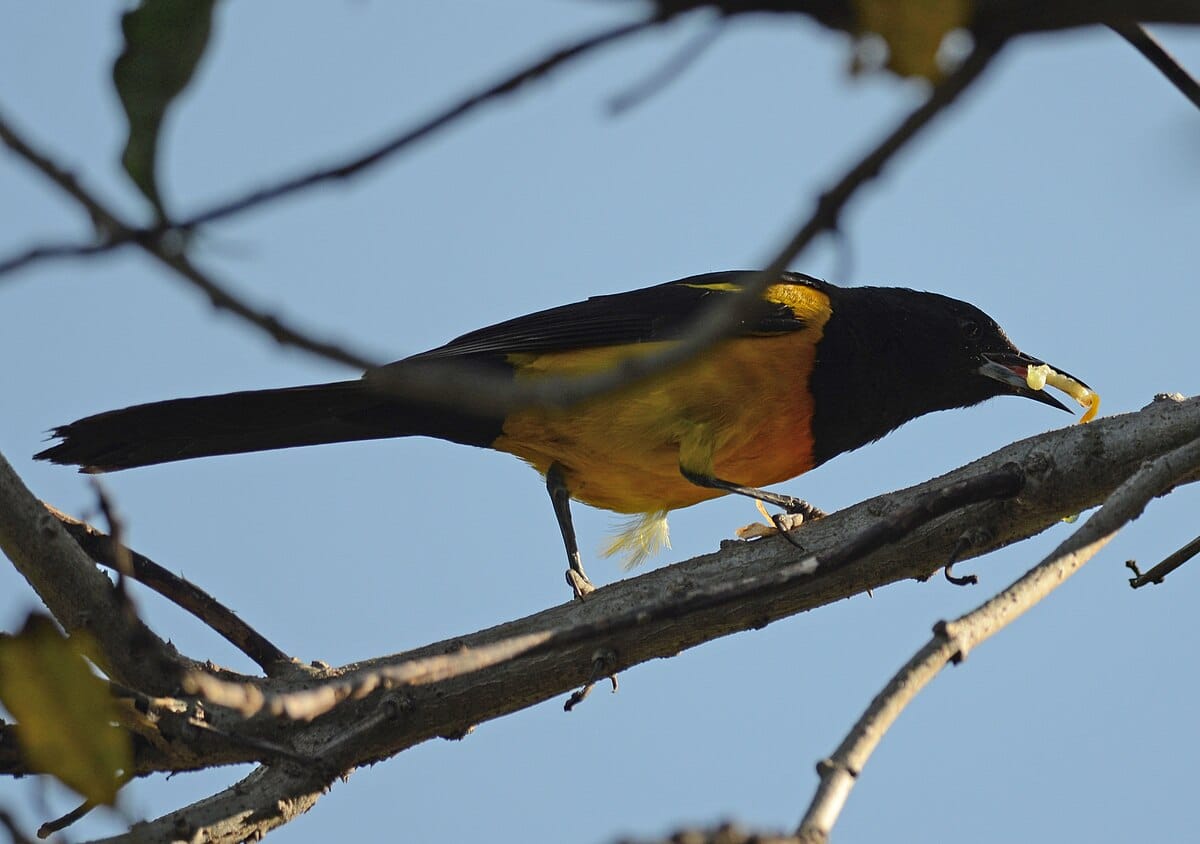
The Black-vented Oriole is a striking bird characterized by a vivid yellow-orange body and contrasting black head, wings, and tail. This oriole is commonly found in Mexico and northern Central America.
Identification Tips:
Size: 8–9 inches long
Coloration: Bright yellow-orange underparts, black head, wings, and tail
Distinguishing Feature: Bold black vent area and striking color contrast
Habitat and Range:
Black-vented Orioles inhabit open woodlands, forest edges, and semi-arid regions. They are typically resident species but may perform local movements in search of food.
Behavior and Diet:
This species feeds on insects, nectar, and fruits. Black-vented Orioles are agile foragers and skilled nest-builders, weaving large pendulous nests from grass, fibers, and plant materials.
Tips for Birdwatchers:
Explore semi-arid woodlands or garden areas in Mexico for the best sightings.
Their vivid yellow-orange coloration and black vent area make them stand out among types of orioles.
The Black-vented Oriole highlights the adaptability of orioles to different habitats while maintaining their signature vibrant coloration and acrobatic feeding behavior.
11. Black-hooded Oriole (Icterus cucullatus)
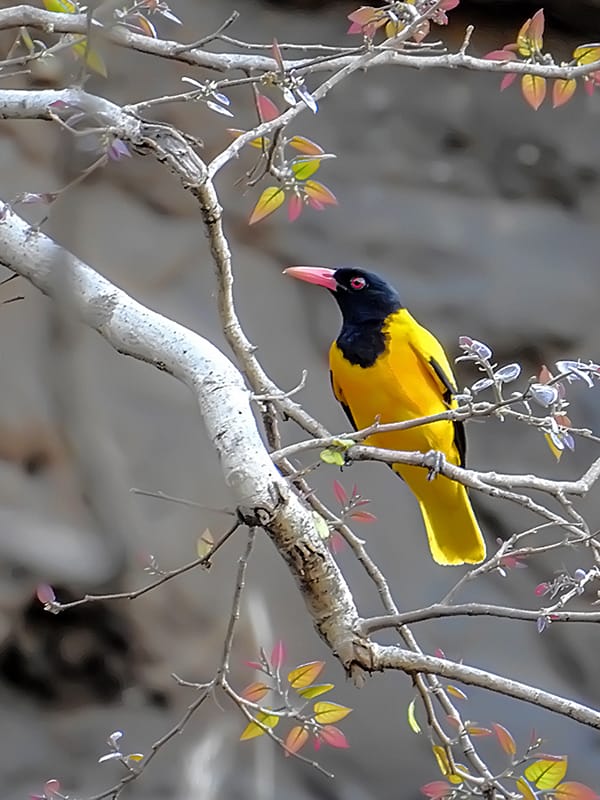
The Black-hooded Oriole is an eye-catching species native to South and Southeast Asia, easily distinguished by its bright yellow body and glossy black hood covering the head and throat. Unlike many New World orioles, this species inhabits tropical and subtropical forests, often near human settlements.
Identification Tips:
Size: 8–9 inches long
Coloration: Bright yellow body, black head and throat, black wings with white wing bars
Distinguishing Feature: The solid black hood is the most defining characteristic
Habitat and Range:
Black-hooded Orioles prefer open forests, gardens, and wooded areas in countries such as India, Sri Lanka, and Indonesia. They are mostly resident, though local movements occur during food scarcity.
Behavior and Diet:
This oriole primarily feeds on insects, nectar, and fruits. Its feeding behavior is agile, often moving through trees with swift, deliberate movements. Black-hooded Orioles build hanging, woven nests from fibers and grasses, which are securely attached to slender branches.
Tips for Birdwatchers:
Look for them in suburban gardens or forest edges early in the morning.
Listen for their melodious, fluting calls that differ from other Asian orioles.
The Black-hooded Oriole enriches the global diversity of types of orioles, demonstrating how orioles have adapted to Asian environments with striking coloration and distinctive behaviors.
12. Black-winged Oriole (Icterus wagleri)

The Black-winged Oriole is a rare but fascinating species primarily found in parts of Central America. Its bright yellow-orange body contrasts sharply with black wings and tail, giving it a bold, dramatic appearance.
Identification Tips:
Size: 8–9 inches long
Coloration: Vibrant yellow-orange body, black wings and tail
Distinguishing Feature: Black wings and tail with vivid yellow underparts
Habitat and Range:
This oriole inhabits forest edges, open woodlands, and secondary growth areas in Central America. It is mostly resident but may move locally in response to fruit availability.
Behavior and Diet:
Black-winged Orioles forage for insects, nectar, and small fruits. They are agile, acrobatic feeders, often seen hanging upside down or moving quickly along branches. Their nests are large, pendulous, and intricately woven, suspended from high tree limbs to deter predators.
Tips for Birdwatchers:
Search near fruiting trees or flowering shrubs for easy sightings.
Their bold black-and-yellow contrast makes them one of the easier orioles to identify in their range.
This species highlights the rich diversity among types of orioles, illustrating adaptations to tropical forest habitats while maintaining the classic oriole vibrant colors.
13. Black-headed Oriole (Oriolus larvatus)

The Black-headed Oriole is an African species known for its brilliant yellow body and striking black head. It is widely found across sub-Saharan Africa and is celebrated for its vibrant appearance and cheerful song.
Identification Tips:
Size: 8–9 inches long
Coloration: Bright yellow body, solid black head and throat
Distinguishing Feature: The contrast between yellow body and solid black head
Habitat and Range:
Black-headed Orioles thrive in forests, woodland edges, and riverine habitats across Africa. They prefer open canopies and areas with scattered trees, adapting well to human-altered landscapes.
Behavior and Diet:
Their diet includes insects, fruits, and nectar. They are active and social foragers, often seen in small groups. Nests are suspended from tree branches, skillfully woven from plant fibers, and positioned high to reduce predation risk.
Tips for Birdwatchers:
Observe early in the morning when activity is highest.
Their black head and bright yellow body make them instantly recognizable among African orioles.
The Black-headed Oriole is an excellent example of types of orioles found outside the Americas, showing how similar ecological niches produce convergent color patterns in different continents.
14. Black-collared Oriole (Oriolus nigricollis)
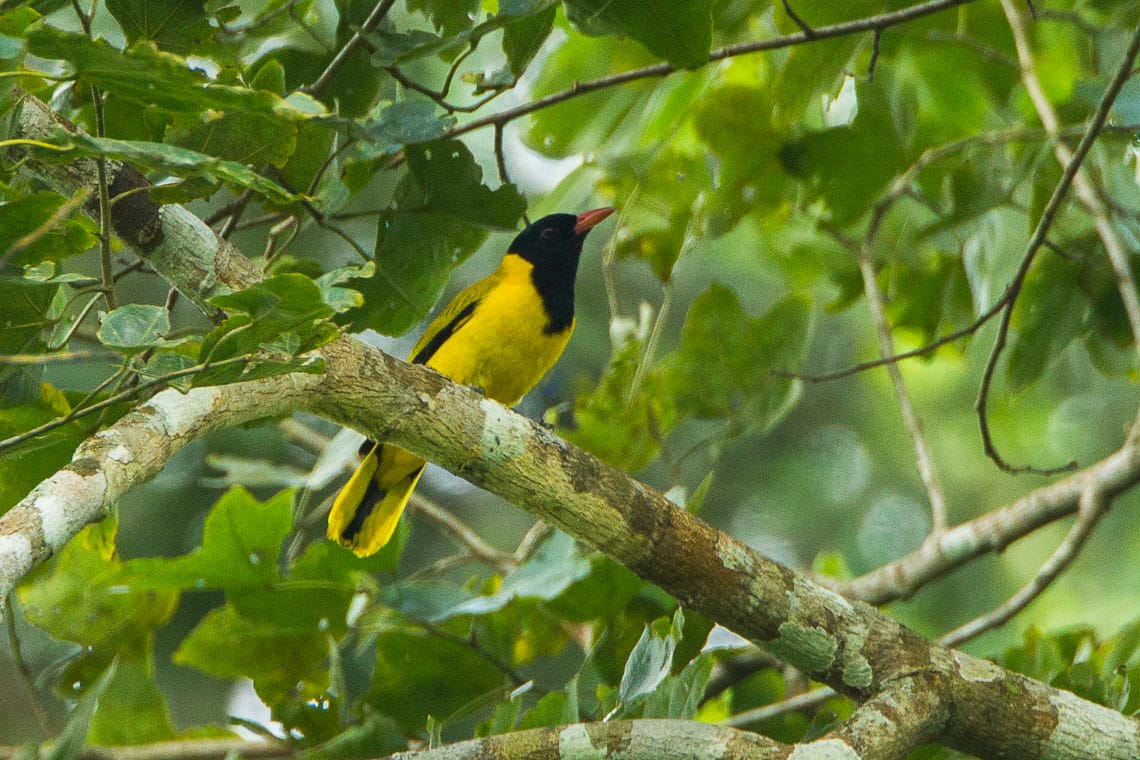
The Black-collared Oriole is an African species named for the distinctive black band across its upper chest. Its bright yellow body and contrasting black wings and tail make it a striking bird in tropical woodlands.
Identification Tips:
Size: 8–9 inches long
Coloration: Bright yellow body, black wings, tail, and chest band
Distinguishing Feature: The black chest band (“collar”) is unique among African orioles
Habitat and Range:
This species inhabits forests, riverine woodlands, and savanna woodlands in tropical Africa. It is mostly sedentary, though it may move seasonally in search of fruiting trees.
Behavior and Diet:
Black-collared Orioles are frugivorous and insectivorous. They forage actively, often in the forest canopy or mid-story, feeding on insects, nectar, and ripe fruits. Their nests are pendulous and woven, strategically placed to avoid predators.
Tips for Birdwatchers:
Listen for their melodious calls echoing through forested areas.
Observe the unique black collar for positive identification.
This oriole adds to the rich spectrum of types of orioles, demonstrating how African species display adaptations to local forested environments while maintaining classic oriole traits like bright coloration and skillful nest-building.
15. Black-billed Oriole (Icterus prosthemelas)
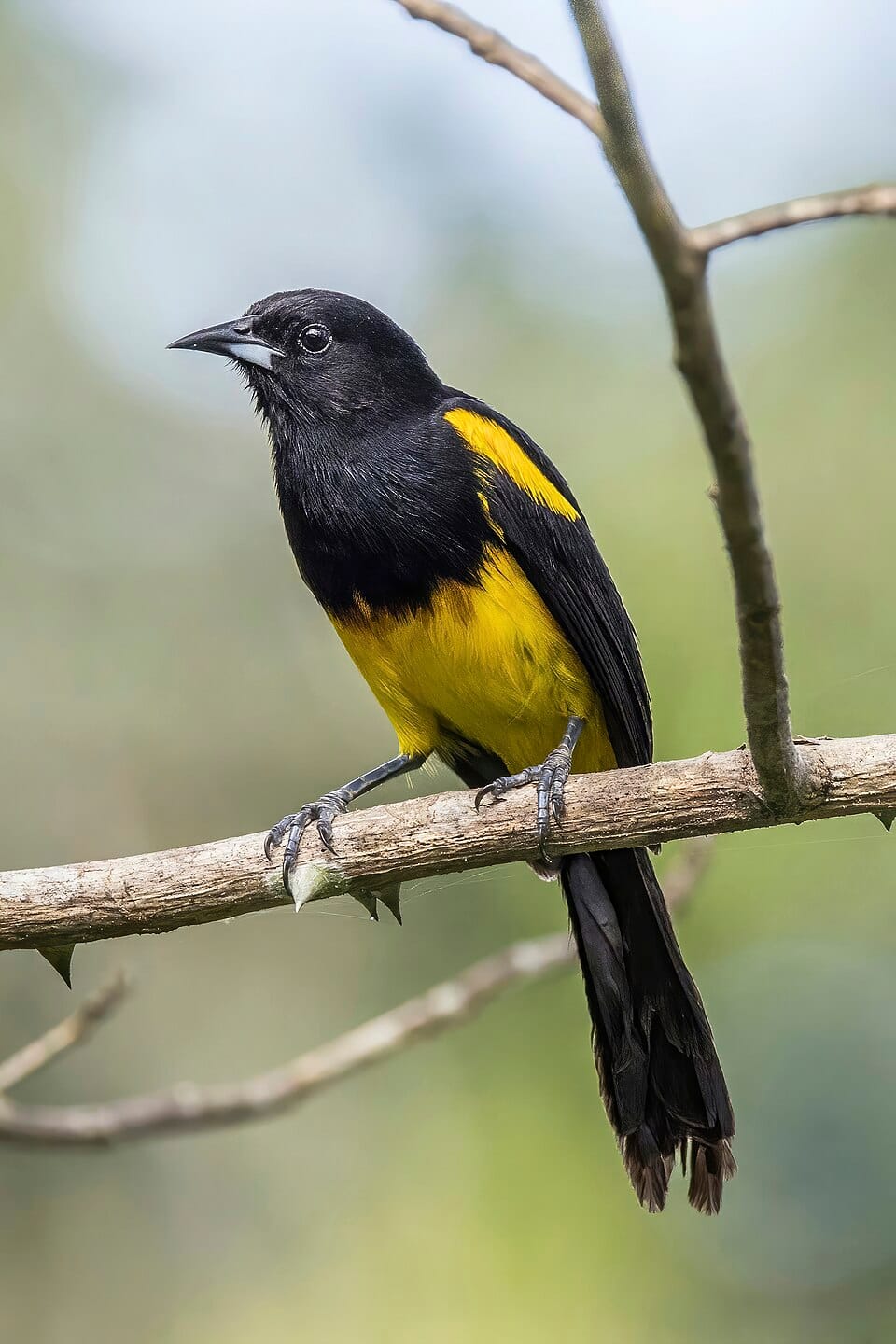
The Black-billed Oriole is native to Central America and is recognized by its yellow body, black head, and distinctive black bill. This species is slightly smaller than some other orioles but still boasts vibrant colors that make it a favorite among birders.
Identification Tips:
Size: 7–8 inches long
Coloration: Yellow body, black head and wings, black bill
Distinguishing Feature: Solid black head with contrasting yellow body and black bill
Habitat and Range:
Black-billed Orioles inhabit tropical forests, forest edges, and plantations in countries such as Honduras, Nicaragua, and Costa Rica. They are largely resident but may shift locations in response to fruit availability.
Behavior and Diet:
This oriole forages actively for insects, nectar, and fruits. Like other orioles, it constructs hanging, woven nests from fibers and grasses, attached to slender tree branches for safety.
Tips for Birdwatchers:
Watch near flowering or fruiting trees in Central American forests.
Their distinctive black bill and head provide easy identification among types of orioles in the region.
The Black-billed Oriole rounds out this section of types of orioles, exemplifying how Central American species adapt to tropical forests while retaining the signature bright yellow-and-black coloration.
16. Montserrat Oriole (Icterus oberi)
The Montserrat Oriole is a striking and endangered bird species found only on the small Caribbean island of Montserrat. Known for its glossy black plumage and vivid yellow belly, this bird is both a national symbol and a conservation success story in progress.
Identification Tips
Size: Around 7.5 inches (19 cm) in length
Coloration: Males have a glossy black head, throat, and back with a bright yellow belly and rump. Females are duller, with olive-yellow tones and a less defined contrast.
Distinguishing Feature: Sharp contrast between the glossy black upper parts and glowing yellow underparts; limited to one island — making it easy to identify by range.
Habitat and Range
The Montserrat Oriole is endemic to the island of Montserrat, meaning it lives nowhere else in the world. It primarily inhabits rainforests and moist woodlands, especially in the Centre Hills region.
After volcanic eruptions in the 1990s destroyed much of its habitat, the oriole’s population sharply declined, making conservation efforts crucial for its survival.
Behavior and Diet
These orioles are insectivorous and frugivorous, feeding on insects, caterpillars, and ripe fruits. They often forage quietly among dense foliage, moving in small family groups.
Their song is rich and melodious — a series of flute-like whistles that echo beautifully through the forest canopy.
Breeding and Nesting
During breeding season (March to August), females build pendulous nests made from plant fibers and moss, suspended from tree branches.
They typically lay two to three eggs. Because of habitat loss, breeding success depends heavily on the protection of undisturbed forest patches.
Conservation Status
The Montserrat Oriole is currently listed as Vulnerable on the IUCN Red List.
After volcanic eruptions devastated its range, populations dropped below 200 individuals. Thanks to local conservation programs, numbers have since increased — but the species remains at risk from habitat loss and invasive predators.
Quick Facts
Scientific Name: Icterus oberi
Family: Icteridae
Endemic to: Montserrat, Lesser Antilles
Conservation Status: Vulnerable (IUCN)
Distinctive Call: Sweet, flute-like whistle
Expert Insight
What makes the Montserrat Oriole remarkable isn’t just its beauty but its resilience. Despite losing much of its habitat to volcanic activity, this bird continues to survive and adapt in the remaining forests. It stands as a symbol of hope for island biodiversity.
Birdwatching Tips
If you’re ever on Montserrat, your best chance of spotting this species is within Centre Hills National Forest Reserve. Early mornings after rainfall are especially rewarding, when males are most vocal and active.
Binoculars and patience are essential — these birds blend easily into the shadowy canopy.
17. Bahama Oriole (Icterus northropi)
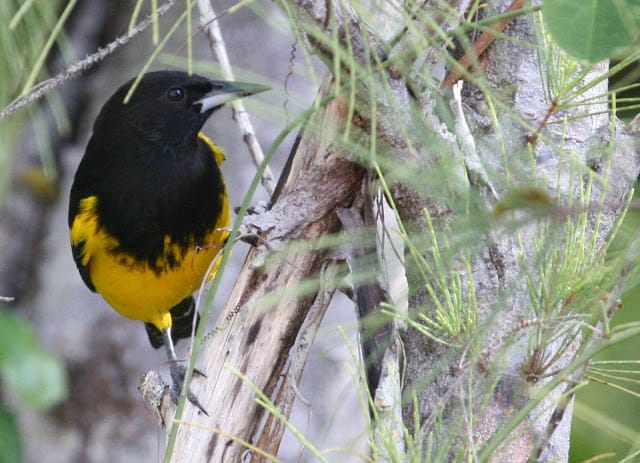
The Bahama Oriole is one of the rarest orioles on Earth — a radiant black-and-yellow songbird found only on the Andros Islands of the Bahamas. Known for its striking colors, melodious call, and unique nesting habits, this oriole is a prized sight for birdwatchers who make the journey to its isolated Caribbean home.
Identification Tips
Size: About 8 inches (20 cm) long
Coloration: Adults are mostly glossy black on the head, back, wings, and tail, with a bright lemon-yellow belly, rump, and shoulders.
Sex Differences: Males are darker and more vividly marked, while females appear slightly duller with olive-yellow tones.
Distinctive Marking: Their bold contrast of black and yellow is paired with a sleek body and slightly curved black bill — a perfect silhouette in Bahamian sunlight.
Habitat and Range
The Bahama Oriole is endemic to Andros Island, meaning it exists nowhere else on the planet.
Historically, it was also found on nearby Abaco, but that population is now extinct.
These orioles prefer coppice forests, coconut groves, and residential areas where tall palms are abundant — they rely on palm fronds for nesting.
Unfortunately, many of their traditional nesting palms have been lost due to hurricane damage, development, and a lethal disease known as lethal yellowing, which affects coconut palms.
Behavior and Diet
The Bahama Oriole is omnivorous, feeding mainly on insects, spiders, fruits, and nectar.
They are active, alert, and often seen flitting through treetops or hovering briefly near flowers.
Despite their rarity, they are vocal birds — their calls are a mix of clear whistles and warbling notes, sometimes resembling flute-like melodies that echo across the coastal forests.
Breeding and Nesting
One of the most fascinating behaviors of the Bahama Oriole is its nesting preference for coconut palms.
The female weaves a hanging basket-like nest from plant fibers, suspended from palm fronds to protect the eggs from predators.
A typical clutch contains 2–4 pale blue or whitish eggs, and both parents share the duties of feeding the chicks.
However, as coconut palms disappear, the species has been forced to adapt — nesting more often in native pines or introduced ornamental trees, which sometimes offer less protection.
Conservation Status
The Bahama Oriole is classified as Critically Endangered by the IUCN.
Its population is estimated at fewer than 500 mature individuals, making it one of the most at-risk songbirds in the Western Hemisphere.
The primary threats include habitat loss, palm tree disease, and predation by invasive species like rats and cowbirds.
Local and international conservation groups have begun breeding studies and habitat restoration efforts to help this species recover.
Quick Facts
Scientific Name: Icterus northropi
Family: Icteridae
Range: Andros Island, The Bahamas
Conservation Status: Critically Endangered (IUCN)
Diet: Insects, fruits, and nectar
Unique Trait: Nests exclusively in palm trees (especially coconut palms)
Expert Insight
The Bahama Oriole is a stunning reminder of how island ecosystems can both nurture and endanger species. Its existence is deeply tied to a single environment — and even a single type of tree.
Protecting these birds means protecting the palm forests and coastal habitats that sustain them.
Birdwatching Tips
To spot the Bahama Oriole, visitors should travel to Andros Island’s pine forests or inland villages where mature palms still stand. Early mornings are best for sightings, especially around flowering trees.
Bring binoculars — their sleek black plumage can blend surprisingly well with the shade of palm crowns.
In summary:
The Bahama Oriole stands as one of the most endangered — yet most beautiful — members of the types of orioles family. Its survival depends on swift conservation efforts, making it a true emblem of Caribbean biodiversity at risk.
18. Cuban Oriole (Icterus melanopsis)
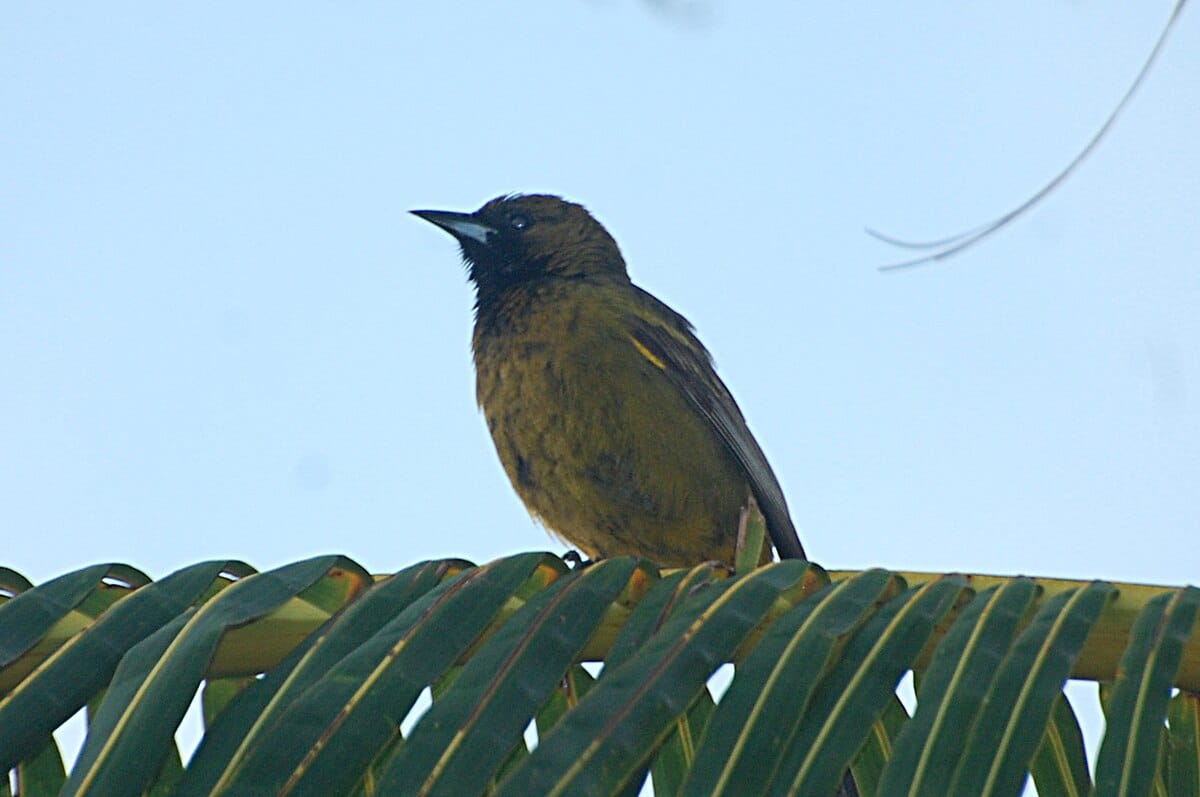
The Cuban Oriole is a dazzling tropical songbird native to the island of Cuba and the Isla de la Juventud. This species is admired for its deep black plumage contrasted by fiery orange-yellow highlights, giving it a bold and exotic appearance. Despite its beauty, the Cuban Oriole remains one of the least-studied birds in the Caribbean — a hidden gem for birdwatchers who love discovering rare species.
Identification Tips
Size: About 8.5 inches (21–22 cm) long
Plumage: Jet-black on the head, wings, and tail with bright orange-yellow patches on the shoulders, belly, rump, and thighs.
Sex Differences: Males and females are nearly identical, though females may appear slightly paler.
Juveniles: More olive-yellow with dark streaking until they mature into their adult coloration.
Distinctive Mark: The bold color contrast between black wings and golden-orange underparts makes them unmistakable, even from a distance.
Habitat and Range
Endemic to Cuba and Isla de la Juventud, this oriole thrives in tropical forests, coastal mangroves, and plantations.
They are particularly common in areas with palm trees and flowering shrubs, often seen perched high in the canopy or foraging along branches for insects and nectar.
While widespread across Cuba, their populations are fragmented, with declines in areas suffering from deforestation and pesticide use.
Behavior and Diet
Cuban Orioles are active and social, often spotted in pairs or small family groups.
Their diet includes a mix of:
Insects and caterpillars
Fruits such as figs and guavas
Nectar from native flowering plants
Their feeding habits play an important role in local ecosystems — they help pollinate flowers and disperse seeds, making them valuable contributors to Cuba’s biodiversity.
They are also highly vocal. The Cuban Oriole’s song is a rich, flutelike melody interspersed with chatter and whistles — a signature sound of the tropical canopy.
Breeding and Nesting
Breeding season runs from March to July, when these orioles construct hanging basket nests woven from grass, bark, and plant fibers.
They often attach their nests to the underside of palm fronds — a trait shared with several other Caribbean orioles.
Both parents participate in raising the young. They defend their territory aggressively, chasing away larger birds that venture too close to their nest site.
A typical clutch contains 2–3 pale eggs, and fledglings leave the nest within 2–3 weeks after hatching.
Conservation Status
The Cuban Oriole is currently listed as Least Concern by the IUCN, but localized declines have been reported due to habitat loss and pesticide exposure.
Because it is confined to one island, even minor environmental disruptions — such as hurricanes or agricultural expansion — can significantly affect its population.
Conservationists in Cuba are working to monitor the species’ population trends and preserve its habitats, especially in protected areas like Guanahacabibes National Park.
Quick Facts
Scientific Name: Icterus melanopsis
Family: Icteridae
Endemic to: Cuba and Isla de la Juventud
Diet: Insects, fruits, nectar
Song: Rich, flutelike notes mixed with chirps and chatters
Conservation Status: Least Concern (IUCN)
Expert Insight
The Cuban Oriole stands out as a symbol of the Caribbean’s hidden birdlife — brilliantly colored, musically gifted, and perfectly adapted to island life.
Its beauty captures the essence of tropical biodiversity, while its resilience highlights how even small, isolated ecosystems can nurture exceptional species.
This oriole’s song, echoing through palm groves and mangroves, remains a natural treasure for Cuba — one that deserves continued protection.
Birdwatching Tips
To observe the Cuban Oriole in the wild:
Visit western and central Cuba, especially forested reserves or agricultural areas near coastal zones.
Early mornings are best, when males sing from exposed perches.
Listen for a bright, rolling whistle followed by soft chatter — an unmistakable clue to their presence.
Bring binoculars and a bit of patience — while these birds are vocal, they tend to stay in high canopies and can be tricky to spot in dense foliage.
In short:
The Cuban Oriole adds a vibrant burst of color to the list of types of orioles. Its lively songs, striking appearance, and ecological importance make it a must-know species for any wildlife enthusiast or birder exploring the Caribbean.
19. Hispaniolan Oriole (Icterus dominicensis)
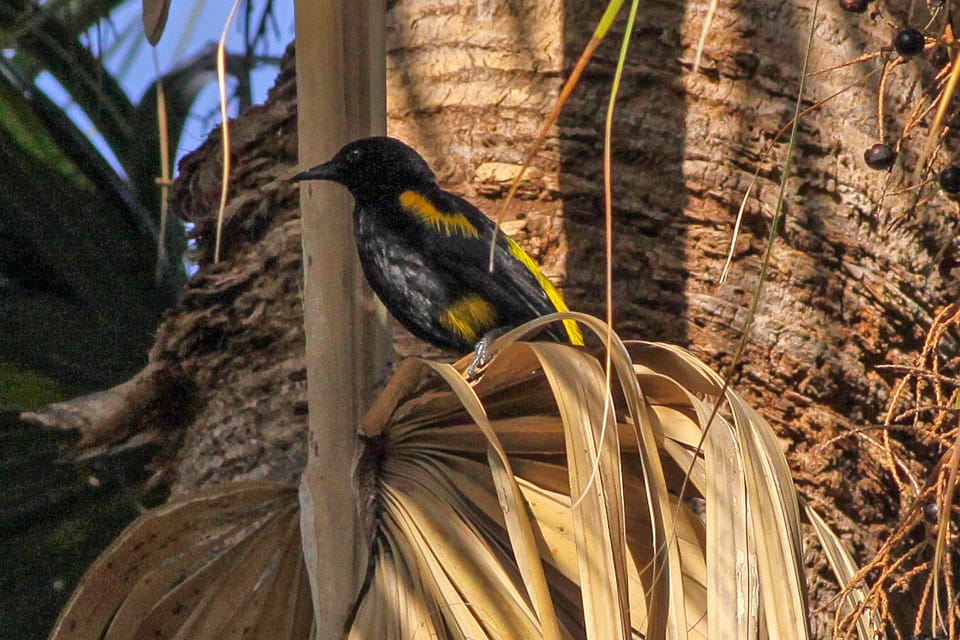
The Hispaniolan Oriole is a striking black-and-yellow bird native to the Caribbean island of Hispaniola, shared by Haiti and the Dominican Republic. With its sleek plumage and clear, melodious song, this bird is one of the most beautiful yet overlooked orioles in the region. It plays an essential role in the local ecosystem as a pollinator, seed disperser, and insect controller.
Identification Tips
The Hispaniolan Oriole measures around 8 inches (20 cm) in length and exhibits a bold color pattern that immediately stands out.
Plumage: Glossy black head, throat, wings, and tail contrasted by a brilliant yellow belly, rump, and shoulder patches.
Bill: Slightly curved, black, and pointed — ideal for probing flowers and fruits.
Sexual Dimorphism: Males and females look similar, though females can appear slightly duller.
Juveniles: More olive-yellow overall with reduced black markings until they mature.
These features give the Hispaniolan Oriole a classic tropical look, resembling the Cuban and Bahama orioles but with more sharply defined coloration.
Habitat and Range
This species is endemic to Hispaniola, meaning it exists nowhere else in the world. It thrives in lowland forests, palm groves, coffee plantations, and gardens.
The oriole has shown great adaptability, often nesting near human settlements where tall palms and fruiting trees provide both food and shelter.
However, habitat loss through deforestation and agriculture continues to reduce the quality of its natural range, especially in rural Haiti.
Behavior and Diet
The Hispaniolan Oriole is active, curious, and social — often seen foraging in pairs or small family groups. Its diet is varied and includes:
Insects and larvae
Ripe fruits (especially figs, papaya, and guava)
Flower nectar
Occasional small invertebrates
They frequently visit flowering trees, where their feeding also helps with pollination. Their movement is quick and deliberate, and they often hang upside down while searching for food on palm leaves and flower clusters.
Their song is a sweet, whistling series of notes — rich, fluid, and somewhat mournful — which they use to mark territory or communicate with their mates.
Breeding and Nesting
Breeding season typically occurs from April through July, coinciding with the island’s wet season when food is plentiful.
The female constructs a pendulous, woven nest made from grass, fibers, and palm threads. It hangs beneath the fronds of palm trees or in tall ornamental plants, providing both camouflage and protection.
A clutch usually contains 2–3 pale eggs, which are incubated by the female for about two weeks. Both parents feed the chicks, bringing a mix of insects and fruit to ensure balanced nutrition.
Conservation Status
The Hispaniolan Oriole is listed as Near Threatened on the IUCN Red List. Its population is stable in certain areas of the Dominican Republic but declining in Haiti due to deforestation and nest parasitism from shiny cowbirds (Molothrus bonariensis).
Conservation programs on the island focus on habitat restoration, particularly protecting native palm species that serve as crucial nesting sites.
Quick Facts
Scientific Name: Icterus dominicensis
Family: Icteridae
Range: Hispaniola (Haiti and the Dominican Republic)
Conservation Status: Near Threatened (IUCN)
Diet: Insects, fruit, nectar
Habitat: Forests, plantations, and gardens
Expert Insight
The Hispaniolan Oriole embodies the delicate balance between nature and human presence. It has adapted remarkably well to life near cultivated areas, showing that wildlife and rural agriculture can coexist. However, ongoing conservation is vital to ensure its survival, as its dependence on palm trees and forest edges makes it vulnerable to land clearing.
This bird’s strong song and bold coloration are a reminder of Hispaniola’s rich biodiversity — and how easily such beauty can disappear without careful protection.
Birdwatching Tips
For bird enthusiasts visiting the Caribbean, Hispaniola offers one of the most rewarding oriole-watching experiences.
The best spots include Los Haitises National Park in the Dominican Republic and Pic Macaya National Park in Haiti.
Early morning hours, just after sunrise, are ideal for hearing their calls.
They are often seen near coconut palms or fruiting fig trees, perching conspicuously before diving into the foliage to feed.
Patience pays off — their glossy black plumage can blend with shaded areas, but once they emerge into sunlight, their golden markings make them truly unforgettable.
In summary:
The Hispaniolan Oriole is a vibrant symbol of Caribbean wildlife, representing both resilience and fragility. With its brilliant colors, graceful behavior, and ecological importance, it deserves a place among the most fascinating types of orioles in the world. Protecting this species means preserving the natural rhythm of Hispaniola’s forests — a legacy that future generations deserve to experience.
20. Orange Oriole (Icterus auratus)

The Orange Oriole is a brilliantly colored tropical bird found in the warm forests of Central America, particularly across Belize, Guatemala, Honduras, and eastern Mexico. With its glowing orange plumage and deep black markings, it’s one of the most striking orioles of the region — yet few outside birding circles have even heard of it. This species represents the vibrant diversity of orioles beyond the well-known North American varieties.
Identification Tips
The Orange Oriole is a medium-sized bird, measuring about 7–8 inches (18–20 cm) long. Its plumage glows with intense hues that make it easy to recognize in the field.
Coloration: Males have a fiery orange head, breast, and underparts, with contrasting black wings, tail, and throat.
Females: Slightly duller, with olive-orange tones and less extensive black on the face.
Juveniles: Greenish-yellow overall, gradually developing adult colors over the first year.
Bill: Slender, black, and slightly curved — typical of insectivorous and nectar-feeding orioles.
When sunlight filters through the forest canopy, the Orange Oriole’s plumage almost seems to glow, earning it a reputation as one of the most beautiful birds of Central America.
Habitat and Range
This species is endemic to Central America, found primarily in Belize, eastern Mexico (Yucatán Peninsula), northern Guatemala, and western Honduras.
It inhabits lowland tropical forests, dry woodlands, and forest edges, often near rivers or cultivated areas with fruiting trees.
Unlike many other orioles, the Orange Oriole has adapted well to moderately disturbed habitats, occasionally appearing in rural gardens or plantations — as long as tall trees and food sources remain available.
Behavior and Diet
The Orange Oriole is energetic, agile, and alert, often seen moving rapidly through the treetops or calling from open perches.
Its diet includes:
Insects (beetles, caterpillars, and spiders)
Fruits such as figs, berries, and mangoes
Nectar from tropical blossoms
These birds are important pollinators and seed dispersers, helping maintain forest health. Their calls are a mix of flutelike whistles and harsh chatter — a lively soundtrack in the tropical canopy.
During the early morning, their duets fill the forest with a melodious rhythm, as pairs communicate across tree gaps using short, echoing notes.
Breeding and Nesting
Breeding season generally spans March through June, aligning with the region’s warmer months.
The female builds a hanging basket nest woven from fibers, palm threads, and grass, suspended beneath a high branch — a structure that sways gently in the breeze, safely out of reach from many predators.
Clutches usually contain 2–4 eggs, which are incubated primarily by the female. Both parents share the responsibility of feeding the chicks, providing insects and soft fruits during the fledgling period.
Interestingly, Orange Orioles sometimes reuse parts of old nests, reinforcing them year after year — a behavior not common among all oriole species.
Conservation Status
Currently, the Orange Oriole is classified as Least Concern by the IUCN, but its population is vulnerable to deforestation and habitat fragmentation.
In parts of Belize and Guatemala, extensive logging has reduced suitable nesting and feeding areas. However, in protected reserves and community-managed forests, populations remain relatively stable.
Conservationists are promoting sustainable forest management practices that help maintain the balance between human activity and the oriole’s tropical habitat.
Quick Facts
Scientific Name: Icterus auratus
Family: Icteridae
Range: Belize, Guatemala, Honduras, and eastern Mexico
Diet: Insects, fruit, nectar
Conservation Status: Least Concern (IUCN)
Distinctive Call: A melodic, flutelike whistle followed by soft chatter
Expert Insight
The Orange Oriole represents a perfect example of tropical adaptation — thriving in both primary and secondary forests. Its vivid color is not just for beauty; it may serve as a visual signal for mates or territorial defense.
Because of its restricted range and reliance on trees for nesting, continued habitat protection is essential for this species to thrive in the wild.
For birdwatchers, spotting the Orange Oriole is often a highlight of any Central American expedition. Its brightness against green foliage and its calm, deliberate movements make it both photogenic and unforgettable.
Birdwatching Tips
If you want to see the Orange Oriole in its natural setting, head to Belize’s tropical reserves or lowland forests of northern Guatemala.
Early morning and late afternoon are prime observation times.
Listen for its two-part whistle, often repeated at steady intervals.
Bring binoculars — though brightly colored, these orioles often stay high in the canopy.
They may also visit garden feeders offering fruit slices or nectar-rich flowers, especially in rural villages surrounded by forest.
In summary:
The Orange Oriole is one of the most breathtaking and lesser-known members of the types of orioles family. Its radiant plumage, lively behavior, and ecological role make it a true gem of Central America’s tropical forests. Beyond its beauty, this bird reminds us of the fragile harmony between wildlife and the forests they call home — a balance worth protecting for generations to come.
FAQ’s
1. What is the most common oriole?
The most common oriole in North America is the Baltimore Oriole. These bright orange-and-black birds are often seen in backyards, parks, and woodlands during spring and summer. Their cheerful whistles and bold colors make them easy to spot once you know what to look for.
2. Is there a difference between an oriole and a Baltimore oriole?
Yes, there is! “Oriole” refers to the entire group of birds in the Icteridae family, which includes several different species. The Baltimore Oriole is just one of them. So, all Baltimore Orioles are orioles, but not all orioles are Baltimore Orioles!
3. What is the difference between Baltimore Orioles and Altamira Orioles?
The Baltimore Oriole and the Altamira Oriole differ in both appearance and habitat. Baltimore Orioles are smaller, with bright orange and black feathers, and are found mostly in eastern North America. Altamira Orioles are larger, deep orange in color, and live year-round in southern Texas, Mexico, and Central America.
4. Are there black Orioles?
Yes, some orioles have mostly black plumage. For example, the Black Oriole, found in Southeast Asia, has shiny black feathers with subtle orange or yellow accents. While not common in North America, these darker species are stunning in their own right.
5. How rare is a golden oriole?
The Eurasian Golden Oriole is quite rare in many areas. In Europe, it’s seen mostly in open woodlands during summer but migrates to Africa for the winter. Spotting one is a special treat for birdwatchers because they’re shy and prefer staying high in the trees.
6. Who is the most famous Baltimore Oriole?
When people talk about the most famous “Baltimore Oriole,” they often mean the baseball team’s legends, like Cal Ripken Jr., known for his record-breaking streak of consecutive games. In the bird world, however, the Baltimore Oriole itself is the star — a symbol of beauty and song across North America.
7. Why are Orioles so rare?
Orioles aren’t truly rare, but they can seem that way because they migrate long distances and only appear in certain regions during specific times of the year. They also prefer tall trees and forest edges, which can make them harder to spot in urban areas.
8. What is the nickname for the Orioles?
For the Baltimore Orioles baseball team, the nickname is simply “The O’s.” When it comes to the birds, some people affectionately call them “orange songbirds” or “jewel birds” because of their vivid colors and sweet melodies.
9. What does it mean if you see an oriole?
Seeing an oriole is often viewed as a symbol of joy, renewal, and sunshine. In many cultures, their appearance marks the return of spring and the start of warmer, brighter days. It’s like nature’s way of saying, “Good things are coming.”
10. Do Orioles return to the same place every year?
Yes! Orioles are known for their loyalty to feeding and nesting areas. Many return to the same backyard feeders or nesting trees year after year. That’s why, if you’ve ever attracted them once, it’s worth keeping your feeder ready for their return each spring.
11. Why not Baltimore Orioles?
This question usually comes up when people wonder why the birds are called “Baltimore Orioles.” The name comes from their orange-and-black plumage, which matched the coat of arms of Lord Baltimore, the founder of Maryland. So “Baltimore Oriole” honors that historic connection.
12. What’s the difference between an oriole and a robin?
Orioles and robins are both colorful songbirds, but they belong to different families. Robins are part of the thrush family and have a red-orange chest with grayish backs. Orioles, on the other hand, have brighter orange feathers, slender beaks, and are known for weaving hanging nests.
13. Why do orioles quit coming to feeders?
Orioles often stop visiting feeders in midsummer because their diet changes. Early in the season, they crave sweet foods like nectar and fruit. Later, they switch to insects to feed their young. Don’t worry — they may return once migration begins again!
14. What does it mean when a bluebird hangs around your house?
When a bluebird hangs around your home, it’s often seen as a sign of happiness, peace, and good fortune. Bluebirds are gentle and bring positive energy wherever they go. They might also be scouting for nesting spots, especially if you have open yards or nearby trees.
15. What is the best food to attract orioles?
Orioles love sweet, juicy foods! Offer orange halves, grape jelly, and nectar made from sugar water. They’re also drawn to bright orange feeders. Fresh fruit and a clean water source will make your yard a top stop on their migratory route.
16. Are orioles intelligent?
Yes, orioles are quite intelligent! They can remember feeding spots, recognize specific feeders, and even learn to trust certain humans. Their ability to weave intricate, hanging nests from plant fibers also shows a remarkable level of skill and problem-solving.
17. What predators threaten Baltimore Orioles?
Baltimore Orioles face several natural threats, including snakes, hawks, crows, and squirrels, which may raid their nests for eggs or chicks. Domestic cats can also be dangerous if orioles nest near human homes. Still, these birds are quick and alert, which helps them avoid most predators.
18. What is the rarest bird of all time?
The rarest bird ever recorded is often considered the Spix’s Macaw, a bright blue parrot from Brazil that nearly went extinct in the wild. Thanks to breeding programs, it’s slowly making a comeback. Among orioles, the Black Oriole of Borneo is one of the rarest species.
19. Do orioles reuse their nests?
Orioles usually build a new nest each year, though they might use materials from an old one. Their hanging nests often get damaged by wind and rain, so building fresh ensures safety for their chicks each breeding season.
20. Is Loriot still alive?
If you’re referring to “Loriot,” the famous German comedian, he passed away in 2011. However, in French, the word “loriot” actually means “oriole”! So yes, the bird itself is very much alive and thriving in parts of Europe, Asia, and Africa.
21. Are Orioles shy?
Orioles can be a little shy at first, especially in busy or noisy areas. But once they feel safe and discover a steady food source, they become more comfortable and may return regularly. Patience is key when trying to attract them to your yard.
22. What did the Orioles used to be called?
The Baltimore Orioles baseball team was originally known as the Milwaukee Brewers (way back in 1901) before relocating and adopting the “Orioles” name, inspired by Maryland’s state bird. The bird itself has always been known as the Baltimore Oriole, named for Lord Baltimore’s family colors.
23. Is there a girl on the Orioles?
As of now, there are no female players on the Baltimore Orioles baseball team, since Major League Baseball remains an all-male league. However, many women work in coaching, sports medicine, broadcasting, and management roles within the organization.
24. Should you feed orioles grape jelly?
Absolutely! Grape jelly is one of an oriole’s favorite treats, especially during migration season. It’s sweet, energy-rich, and mimics the fruit they love in the wild. Just make sure it’s pure jelly (not jam with seeds) and keep it fresh to avoid attracting ants or bees.
25. Will orioles eat dried mealworms?
Yes, orioles will eat dried mealworms, especially when they’re feeding chicks and need extra protein. However, they usually prefer live insects or soft foods. Offering mealworms alongside fruit or nectar can make your feeder even more appealing.
26. When to stop feeding orioles?
You should stop feeding orioles when they begin their fall migration, usually around late August or early September in most areas. As they prepare to fly south, their diet shifts more toward insects and natural fruits. However, keeping your feeders out a little longer can help late migrators fuel up for their long journey.
27. What is the biggest wild pig in the world?
Oops! That’s a pig question, not an oriole one — but to answer quickly, the biggest wild pig is the Giant Forest Hog of Africa, which can weigh up to 600 pounds. Now, back to orioles!
28. What’s the best way to keep orioles coming back each year?
The secret is consistency! Put your feeders out early in spring before they arrive, offer their favorite foods (grape jelly, oranges, and nectar), and keep everything clean. Once orioles know your yard is a reliable food stop, they’ll remember it and return year after year.
29. Do orioles get along with other birds?
Orioles are generally peaceful but can be a little territorial about their food. They often chase smaller birds away from feeders but usually share space with hummingbirds and finches without major issues. Having multiple feeding stations helps everyone get along.
30. Why are orioles loved by birdwatchers?
Orioles are loved for their stunning colors, melodic songs, and charming personalities. They bring a burst of orange energy to any garden and announce the start of spring with their cheerful calls. For many bird lovers, seeing an oriole feels like a little gift from nature.
Conclusion
Orioles are some of the most captivating and colorful birds in the world, ranging from the familiar Baltimore Oriole of North America to exotic species in Africa and Asia. The 20 types of orioles explored here highlight the incredible diversity in size, coloration, behavior, and habitat. Whether you are a beginner birdwatcher or a seasoned enthusiast, understanding these species enhances your ability to identify, appreciate, and protect them.
Tips for Birdwatchers:
Plant fruiting trees or provide nectar feeders to attract orioles to your backyard.
Learn their songs and calls to locate them more easily.
Observe nesting behaviors to better understand their life cycle and ecology.
By exploring and documenting these vibrant birds, we contribute to conservation efforts and foster a deeper connection with the natural world. Start observing orioles today and experience the beauty and diversity that these remarkable birds bring to every landscape.
Read more:
